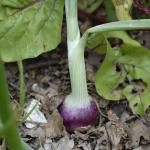Growing Onion
Allium cepa : Amaryllidaceae / the onion family
| Jan | Feb | Mar | Apr | May | Jun | Jul | Aug | Sep | Oct | Nov | Dec |
|---|---|---|---|---|---|---|---|---|---|---|---|
| S | |||||||||||
| T |
(Best months for growing Onion in Canada - Zone 3a Temperate Short Summer regions)
- S = Plant undercover in seed trays
- T = Plant out (transplant) seedlings
- Easy to grow. Grow in seed trays, and plant out in 4-6 weeks. Sow seed at a depth approximately three times the diameter of the seed. Best planted at soil temperatures between 46°F and 86°F.
- Space plants: 2 - 4 inches apart
- Harvest in 25-34 weeks. Allow onions to dry before storing.
- Compatible with (can grow beside): Lemon Balm, Borage, Carrots, Beets, Silverbeet, Lettuce, Amaranth
- Avoid growing close to: Peas, Beans
Onions come in a range of colours and shapes and sizes. Brown - strong flavour and pungent. Usually good keepers for storage. White - milder but still flavoursome. Keep fairly well. Red - Mild, suitable to use raw in salads and sandwiches. The seedlings should be allowed to gain a bit of strength before planting out - usually 4 to 6 weeks will be enough. When they are big enough to handle, you can plant out. They start off looking like blades of grass.
They don't have to be in a greenhouse (though that would be ideal), any sheltered spot will do. The idea is to guard against rapid changes of temperature, especially at night.
Onions can be bought as young plants (sets or seedlings) from garden shops/nurseries to plant straight into garden beds. Choose your variety according to your climate and the time of year as some onions will grow better in the cooler months .
Onion bulbs should sit on the surface of the soil. Do not cover. They will take six to eight months to mature. Onions are ready when the tops start to dry and fall over. Pull them and leave to dry for a few days. Store in a cool, dry airy place. Use a net bag or make a string by weaving the tops together.
Culinary hints - cooking and eating Onion
Brown onions roasted whole with other vegetables are delicious.
Red onions add colour to salads or stir-fry.



Your comments and tips